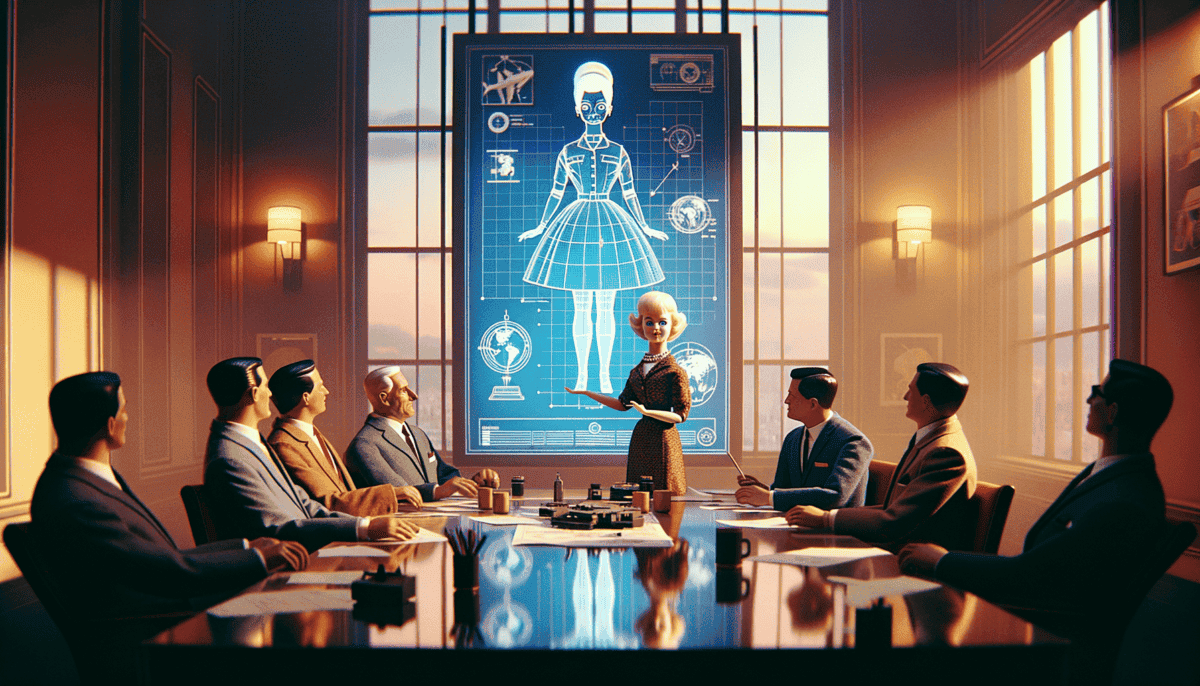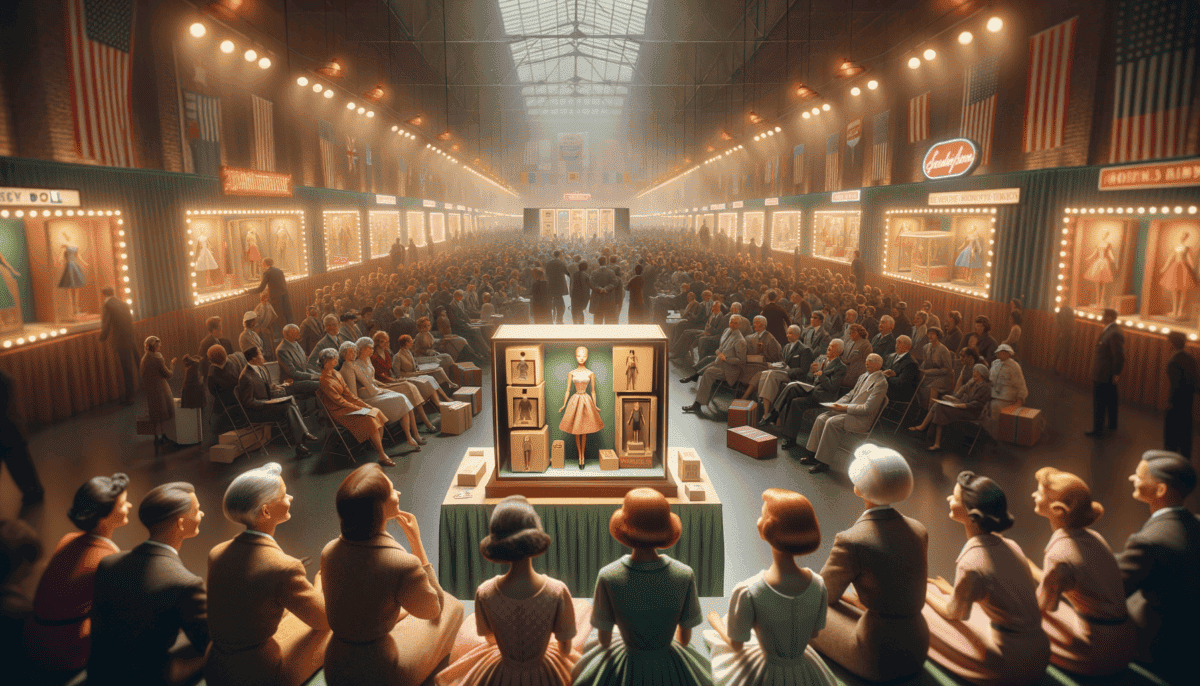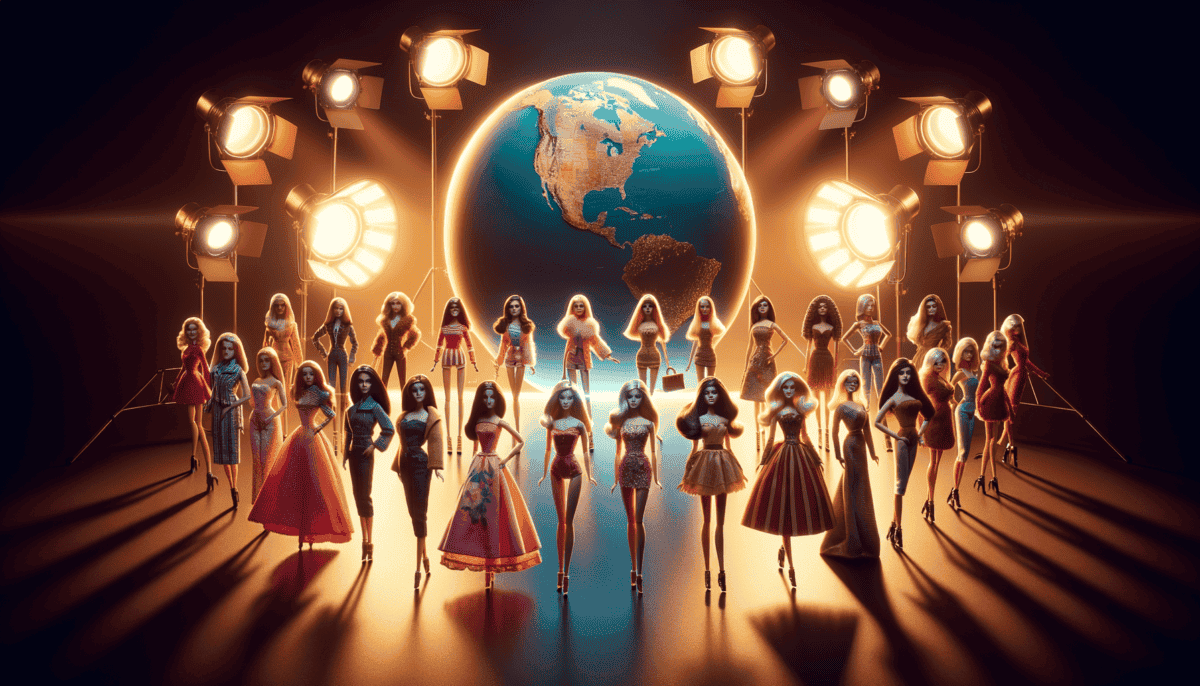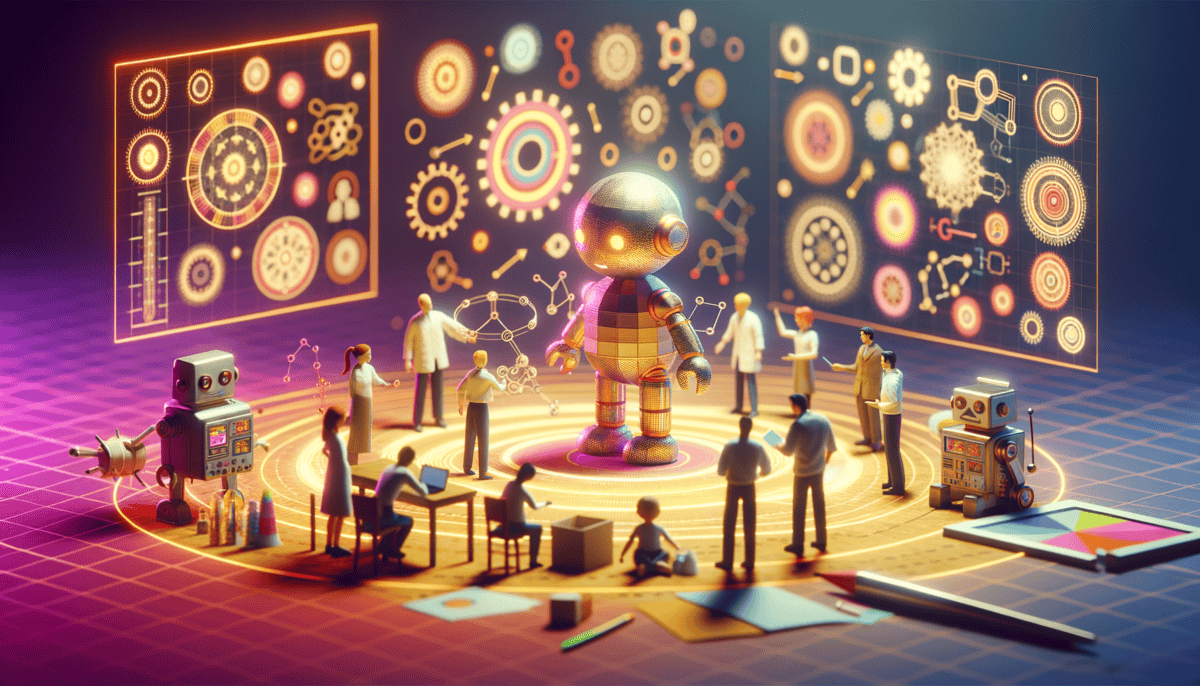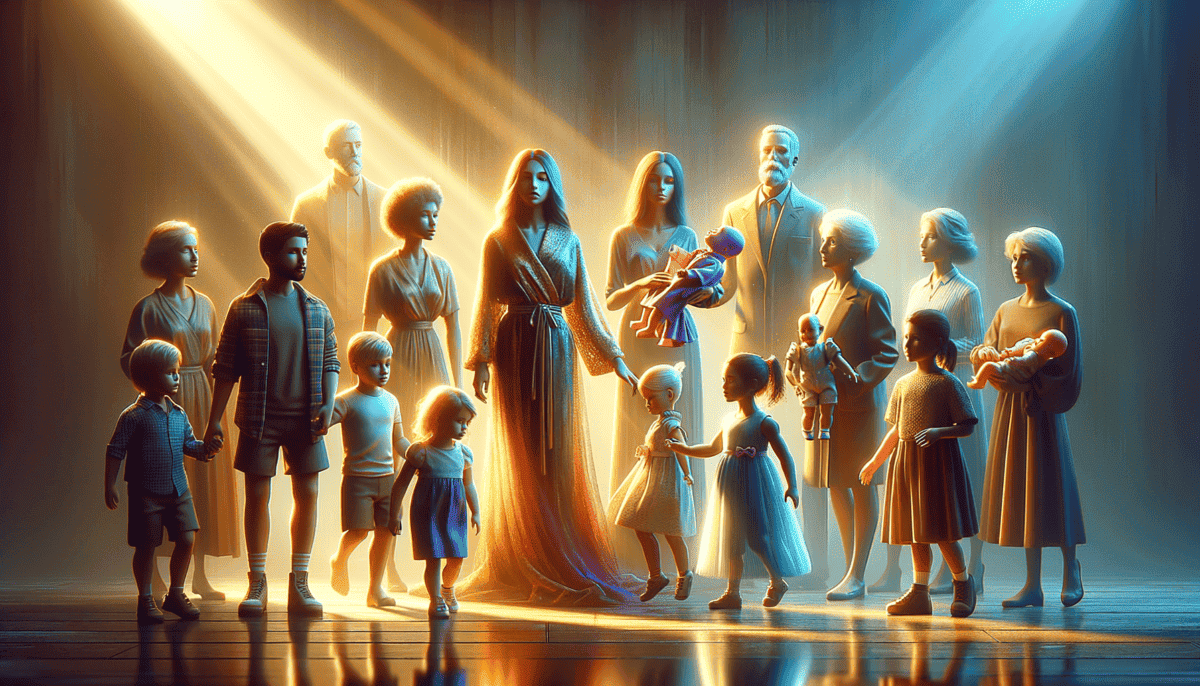A Daughter’s Imagination
On a sunny afternoon in 1956, Ruth Handler watched her daughter Barbara playing in their Los Angeles home. Little Barbara wasn't playing with baby dolls like other girls. Instead, she had paper dolls spread across the floor.
"Mommy, look!" Barbara said, holding up a paper doll dressed in a tiny business suit. "She's going to work just like you!"
Ruth smiled. She knew exactly what her daughter meant. Barbara loved pretending her dolls were grown-ups with exciting lives. But paper dolls were so fragile – they kept tearing and getting crumpled.
"Why don't they make dolls that look like grown-ups?" Barbara asked one day. This simple question made Ruth think hard. All the dolls in toy stores were baby dolls. Girls like Barbara wanted to imagine their future, not just play mommy.
Ruth knew about running a business. She worked hard at Mattel, the toy company she owned with her husband Elliot. But this idea was special – it came from watching her own daughter play.
"What if we made a doll that looks like a teenager or young woman?" Ruth asked Elliot one evening. "Girls could dress her up in different clothes and imagine all the things they could be when they grow up!"
Elliot wasn't sure at first. "No one has ever made a doll like that before," he said.
"That's exactly why we should do it!" Ruth replied with excitement.
Later that year, Ruth went on a trip to Germany with Barbara and her son Kenneth. In a shop window, she saw something amazing – a grown-up looking doll called Lilli! The doll was actually meant for adults, but Ruth saw something different. She bought three Lilli dolls and brought them home.
Back home, Ruth got busy. She worked with designers to create a new kind of doll. They made lots of changes to the Lilli doll's design. The new doll would have pretty clothes and soft hair that girls could brush and style.
"What should we name her?" Ruth asked Barbara.
"How about after me?" Barbara suggested with a giggle.
And that's how Barbie got her name!
Ruth wanted Barbie to be special. She would be a teenage fashion model, but that was just the beginning. Barbie could be anything! A doctor, a teacher, an astronaut – just like real girls could grow up to be anything they wanted.
Some people at Mattel didn't think Barbie was a good idea. They said parents wouldn't want to buy their daughters a doll that looked like a teenager. But Ruth believed in her idea. She knew that girls like Barbara needed a doll that could help them dream about growing up.
“If a little girl could be anything, her doll should be able to do the same!” – Ruth Handler
Every night, Ruth would work on plans for Barbie. She chose pretty fabrics for Barbie's clothes and thought about what kind of box she should come in. She wanted everything to be perfect for when Barbie would finally meet the world.
Breaking Toy Industry Barriers
The year was 1957, and Ruth Handler was ready to share her big idea. But being a woman with a new toy idea wasn’t easy back then.
“A teenage fashion doll? That will never work!” said one toy company man, shaking his head. But Ruth didn’t give up.
Ruth worked hard to make her dream come true. She gathered a special team at Mattel to help create the perfect doll. Jack Ryan, a clever designer, joined the team.
“We need to make her beautiful,” Ruth explained, “but also strong enough for children to play with every day.”
The team tried many different ways to make Barbie. They wanted her hair to be soft and brushable. Her clothes needed to be easy to change. Most importantly, she needed to stand up on her own two feet!
“Girls deserve a doll that shows them they can be anything!” Ruth would say whenever someone doubted her idea.
Making the first Barbie wasn’t easy. The team had to solve lots of problems:
Barbie’s First Challenges:
• Finding the right plastic that wouldn’t break
• Creating hair that looked real
• Making tiny clothes that fit perfectly
• Designing a face that looked friendly and pretty
• Creating joints that could move smoothly
One day, a toy store owner visited Mattel. “No one will want to buy a doll that’s not a baby,” he said. “That’s not what little girls want!”
Ruth smiled and replied, “Have you asked the little girls what they want?”
She remembered watching Barbara play with her paper dolls. Ruth knew in her heart that girls wanted more than just baby dolls. They wanted to dream about growing up!
The team worked day and night. They made many different versions of Barbie before getting it just right. Some had hair that was too stiff. Others had faces that didn’t look friendly enough.
Finally, after months of hard work, the first perfect Barbie was ready. She wore a black and white striped swimsuit and had her hair in a ponytail. Her face was pretty and kind, with a gentle smile.
✨ Soft blonde hair in a ponytail
Black and white striped swimsuit
Blue eyes with a friendly look
High-heeled feet
Real eyelashes
“She’s beautiful!” Barbara exclaimed when she saw the final doll. “Can she have lots of different clothes?”
“Yes!” Ruth answered. “She’ll have outfits for every job and adventure a girl might dream of!”
Even though many people still didn’t believe in Barbie, Ruth knew she was ready to show her to the world. The next big step would be the New York Toy Fair, where all the important toy sellers would see Barbie for the first time.
Ruth packed her bags and carefully placed the very first Barbie in a special box. She was nervous but excited. Soon, everyone would see what she had known all along – that girls needed a doll who could help them imagine all the wonderful things they could be when they grew up. ⭐
The New York Toy Fair Revolution
The big day finally arrived! It was March 9, 1959, and Ruth Handler stood proudly at the New York Toy Fair. She had decorated her booth with sparkly pink fabric and tiny spotlights.
“Ladies and gentlemen,” Ruth announced with a bright smile, “meet Barbie!” She carefully lifted the doll from her special display case.
Some people gasped when they saw Barbie. Others whispered to each other. No one had ever seen a doll quite like her before!
“Look at all her outfits!” a little girl squealed, pointing at the tiny clothes on display. There were party dresses, business suits, and even a tennis outfit!
“Each outfit shows girls they can be anything – a teacher, a nurse, or even a business owner!” Ruth explained to the crowd.
Not everyone loved Barbie right away. Some toy store owners walked past without even stopping to look. But others couldn’t take their eyes off her!
What Made Barbie Special:
• Her grown-up look
• Beautiful clothes that were easy to change
• Soft hair that could be styled
• Bendable legs and arms
• Pretty face with real eyelashes
“We’ll take 500 dolls!” said one excited store owner. Ruth’s heart jumped with joy. Soon, more store owners started placing orders.
By the end of the first day, something amazing happened – Mattel had orders for 20,000 Barbies! Ruth could hardly believe it.
“We need to start making more dolls right away!” she told her team over the phone. The factory would need to work extra hard to make all these Barbies!
Back at home, things got very busy. Workers at the Mattel factory made dolls as fast as they could. They needed special machines to make Barbie’s tiny shoes and to style her hair just right.
✨ 350,000 Barbies sold
Thousands of tiny outfits made
TV commercials showing girls playing with Barbie
Fan letters from happy children
Children everywhere fell in love with Barbie. They wrote letters to Mattel saying how much they liked their new dolls.
“Dear Barbie Makers,” one letter said, “I love that my Barbie can be a doctor one day and a movie star the next!”
Ruth knew she needed to keep making Barbie even better. She started planning new outfits and accessories. Maybe Barbie needed a car? Or a house? Or even some friends?
The newspapers started writing about Barbie. Television shows wanted to talk about her too. Everyone was curious about this new kind of doll that was different from anything else in toy stores.
“Finally,” Ruth thought, “girls have a doll that helps them dream big!” Her idea that started by watching her daughter play with paper dolls had turned into something incredible.
As orders kept coming in, Ruth and her team worked harder than ever. They wanted to make sure every child who wanted a Barbie could have one. Each doll was carefully made and dressed before being sent to stores.
Barbie wasn’t just a toy anymore – she was becoming something special that would change how children played forever! ⭐
From Doll to Cultural Icon
As Barbie grew more popular, Ruth had a big idea. “Why should Barbie have just one job?” she wondered. “Girls can be anything they want!”
In 1960, Barbie became a fashion designer with her own tiny sewing machine. The next year, she was a nurse helping people get better. Children loved seeing Barbie try new careers!
“My Barbie is going to be president someday!” said Sally, a little girl playing with her doll. Ruth smiled – this was exactly what she had hoped for. ⚕️
But something was missing. Ruth looked at all the children playing with Barbie and noticed they didn’t all look the same. So why should all Barbies look the same?
“Every child should have a doll that looks like them,” Ruth declared to her team.
In 1967, Barbie got her first friend who looked different – Christie! She had beautiful brown skin and dark hair. Many children were so happy to see a doll that looked like them.
Barbie’s Amazing New Jobs:
• Space Explorer
• Race Car Driver
• Computer Engineer
• Chef
• Olympic Athlete
Barbie didn’t just stay in America. She traveled all around the world! Children in Japan, Brazil, and France wanted their own Barbies too.
“Bonjour, Barbie!” said children in France.
“Konnichiwa, Barbie!” said children in Japan.
“Olá, Barbie!” said children in Brazil.
To make children in different countries happy, Mattel made special Barbies wearing clothes from their cultures. There were Barbies in beautiful kimonos, colorful saris, and traditional African dresses.
Hawaiian Barbie
Japanese Barbie
Mexican Barbie
Indian Barbie
Teachers started using Barbie to help children learn about different jobs and cultures. “When children play with Barbie, they learn they can be anything,” one teacher said.
Barbie even helped some children feel brave when times were hard. In hospitals, little girls played with doctor Barbie while getting better. At school, teacher Barbie helped shy kids feel more confident.
Famous artists and fashion designers wanted to make special clothes for Barbie. They created tiny versions of beautiful dresses and fancy outfits. Some of these Barbies were so special, they went to museums!
Television shows started making Barbie cartoons. Books told stories about Barbie’s adventures. Children could watch Barbie solve mysteries, help friends, and save the day.
“Barbie shows us that girls are strong and smart,” said Maria, holding her favorite doll. “She makes me feel like I can do anything!”
Ruth watched as Barbie became more than just a toy. She was a friend who helped children dream big dreams. She was a teacher who showed them new things about the world. And most importantly, she was a hero who proved that anything is possible! ⭐
Standing Up to Challenges
As Barbie became more famous, some people started asking questions. “Why does Barbie look so different from real people?” they wondered.
“Kids need dolls that look more like their friends and family,” said Jane, a mom from Chicago. Many parents agreed with her.
Ruth and her team at Mattel listened carefully. They wanted every child to feel good when playing with Barbie. So they started making big changes!
“We want all children to see themselves in Barbie,” the Mattel team said.
In 2016, Barbie got a whole new look. Now children could choose from dolls with different:
• Skin colors
• Hair types
• Face shapes
• Heights
“Look, this Barbie has curly hair just like me!” said Maria, holding her new doll. “And this one uses a wheelchair like my cousin!” said Tom.
The toy stores were filled with all kinds of new Barbies. Some were tall, some were short. Some had round tummies, others had strong muscles. They all wore cool clothes and had fun jobs!
Barbies with prosthetic legs
Barbies in wheelchairs
Barbies wearing hijabs
✨ Barbies with vitiligo
Mattel also made sure Barbie kept up with new technology. They created dolls that could talk, move, and even connect to computers!
“Can you help me code this game?” Barbie would say in her robot voice. Children loved learning about computers with their dolls.
Some people worried that playing with dolls wasn’t good for kids. But scientists did research and found out something amazing! Playing with dolls helps children:
Use their imagination
Practice solving problems
Understand different feelings
“When I play with my Barbies, I make up stories about helping people,” said Sarah, age 7. “It’s like practicing being a good friend!”
Mattel created a special team just for listening to what kids and parents wanted. They read letters, watched how children played, and asked lots of questions.
“Dear Barbie Makers,” wrote Emma, age 8. “Can you make a Barbie that looks like my mom? She’s a firefighter!”
The team worked hard to make these wishes come true. They made Barbies with different jobs, different looks, and different stories. Each new doll helped more children feel seen and special.
Teachers and doctors started saying nice things about the new Barbies. “These dolls help children feel good about themselves,” said Dr. Smith. “They show that everyone is beautiful in their own way.”
Barbie wasn’t just changing – she was growing up with each new generation of children. She became braver, stronger, and more like the real people who loved her.
The best part? Every time Mattel made a new kind of Barbie, more children found a doll they could connect with. “This is the best Barbie ever!” became something children said again and again. ⭐
Building a Future Together
Today, Barbie’s story keeps getting bigger and better! Kids all around the world love playing with their Barbies in new and exciting ways.
“I saw the Barbie movie three times!” said Lucy, jumping up and down. “I love how she shows girls can do anything!”
Ruth Handler’s dream came true in ways she never imagined. Her little idea to make a new kind of doll changed how kids play forever.
“Every child deserves to see themselves in their toys,” Ruth once said. Now, they really can!
Barbie has had more than 200 careers! Here are some of her amazing jobs:
• Doctor
• President
• Video Game Developer
• Marine Biologist
“When I grow up, I want to be a scientist like Scientist Barbie!” said Mai, age 7, while playing in her toy lab coat.
The Mattel toy company keeps finding new ways to make Barbie special. They listen to what kids want and work hard to make those wishes come true.
She speaks many languages
She teaches kids about computers
♻️ She cares about the environment
She helps others
Kids don’t just play with Barbie – they learn from her too! “My Barbie shows me I can be anything,” said Jordan, holding up his favorite doll.
Barbie has friends from all over the world. They have different skin colors, different clothes, and different ways of living. But they all work together and have fun!
“I love that my Barbie wheelchair matches the one I use,” said Sophie. “It makes me feel like I can have big adventures too!”
The future looks bright for Barbie! Mattel keeps thinking of new ideas to make her even better. They want every child to feel special when they play with their dolls.
• Help more kids learn about technology
• Teach about taking care of our planet
• Show even more different kinds of people
• Create new ways to play and learn
From a simple idea in Ruth’s head to a friend that millions of children love, Barbie has come a long way!
Now, whenever a child picks up a Barbie doll, they’re holding more than just a toy. They’re holding a reminder that they can be anything they want to be!
“Barbie taught us that dreams have no limits,” said Anna, looking at her collection of dolls. “And that’s the most important lesson of all!”
As the sun sets on our story, Barbie continues to inspire new generations. She shows that when we believe in ourselves and each other, amazing things can happen! ✨
And somewhere, Ruth Handler must be smiling, knowing that her little idea has helped millions of children dream big dreams.


